Engineering Properties of Modified Rubberized Concretes: Role of Metakaolin and Ground Blast Furnace Slag as Ordinary Portland Cement Replacements
Abstract
:1. Introduction
2. Materials and Methods
2.1. Preparation of Materials and Mix Design
2.2. Specimens Preparation and Curing Regime
2.3. Tests Procedure
3. Results and Discussion
3.1. Effect of GBFS and MK Content on CS Development
3.2. Effect of DSRTs Content on CS of Proposed MRCs
3.3. X-ray Diffraction (XRD) Patterns Analysis
3.4. Thermogravimetric Analysis
3.5. Effect of Rubberization on Tensile Strength
3.6. Flexural Strength
3.7. Modulus of Elasticity (MOE) of Proposed Concrete
3.8. Modified Concrete Porosity
3.9. Impact Resistance
4. Conclusions
- The replacement of 30% of OPC with GBFS-MK binders significantly enhanced the bond strength between the modified cement pastes and DSRTs surfaces.
- The inclusion of 5, 10, 15, 20, and 25% MK as an OPC replacement in the ternary binder matrix delayed the hydration process, resulting in lower CS at early ages of 3 and 7 days. However, the specimens tested after 28, 56, and 90 days exhibited excellent strength performance.
- At 28 days of curing age, the inclusion of 10% MK as an OPC replacement in the OPC-GBFS matrix significantly increased the CS value from 41.2 and 42.3 MPa to 46.4 MPa. This content was selected as an optimal level for preparing the MRC specimens with varying levels of DSRTs.
- The results of microstructural analysis (XRD, TGA, and DTG) showed that the inclusion of 30% GBFS and MK as a substitute for OPC positively enhanced the aluminosilicates content and increased the formulation of dense gels. The improvement in the hydration process significantly enhanced the bond strength properties and led to higher CS performance compared to the control specimens.
- The incorporation of GBFS, MK, and DSRTs into the matrix of the studied MRCs achieved satisfactory CS (up to 30 MPa) after 28 days of curing age, making it advantageous for various applications in the concrete industry.
- For the MRC specimens subjected to CS strength testing, it was observed that increasing the DSRTs content, either as fine or/and coarse NAs, in the proposed concrete matrix from 5% to 25% led to a reduction in strength values across all tested ages (3, 7, 14, 28, 56, and 90 days). However, the performance of MRCs after 28 days of age was significantly better than at earlier ages (3–7 days). A similar trend of results was observed for TS, FS, and MOE, where the strength values tended to decrease as the replacement level of NAs with DSRTs increased.
- The porosity of MCR specimens was found to be inversely related to the content of DSRTs, with the highest porosity recorded in specimens containing 25% DSRTs as a replacement for NAs.
- The inclusion of 5, 10, 15, 20, and 25% DSRTs as replacement for fine or/and coarse NAs significantly enhanced the ductility performance of MRCs by increasing resistance to external impact loads. The highest UIE was achieved with specimens containing 25% DSRTs. It is well known that increasing the DSRTs content in MRC mixtures leads to greater absorption of load, resulting in high IR performance. Additionally, the UIE of the proposed MRCs showed a linear relationship with a high coefficient of determination.
5. Recommendation for Future Investigation
- Durability evaluation: An evaluation of the durability of modified cement containing GBFS and MK with various content of DSRTs is a prerequisite for a wide range of applications in the construction sector.
- Bond behavior: The effect of drying shrinkage and creep on the bond behavior between surfaces of rubberized aggregates and modified cement paste should be thoroughly investigated.
- Sustainability and environmental impact: Utilizing DSRTs in the concrete industry can significantly reduce landfill problems, fire risks, and the demand for natural aggregates, while also saving cost and energy. It is highly recommended to conduct studies on lifecycle assessment and the environmental benefits of the proposed rubberized concretes.
Author Contributions
Funding
Institutional Review Board Statement
Informed Consent Statement
Data Availability Statement
Acknowledgments
Conflicts of Interest
Abbreviations
| CS | Compressive strength |
| DSRTs | Discarded rubber tiers |
| GBFS | Ground blast furnace slag |
| IR | Impact resistance |
| NAs | Natural aggregates |
| MRCs | Modified rubberized concretes |
| MOE | Modulus of elasticity |
| MK | Metakaolin |
| FS | Flexural strength |
| TS | Tensile strength |
| OPC | Ordinary Portlandite cement |
| IIE | Initial impact energy |
| UIE | Ultimate impact energy |
| XRD | X-ray diffraction |
References
- Mirza, J.; Huseien, G.F.; Shah, K.W.; Kirgiz, M.S. Reduction in ecology, environment, economy and energy in concrete industry using waste materials. J. Adv. Compos. Mater. Constr. Environ. Nano Technol. 2020, 1–7. [Google Scholar]
- Duthinh, D.; Starnes, M. Strength and Ductility of Concrete Beams Reinforced with Carbon Fiber-Reinforced Polymer Plates and Steel. J. Compos. Constr. 2004, 8, 59–69. [Google Scholar] [CrossRef]
- Pešić, N.; Živanović, S.; Garcia, R.; Papastergiou, P. Mechanical properties of concrete reinforced with recycled HDPE plastic fibres. Constr. Build. Mater. 2016, 115, 362–370. [Google Scholar] [CrossRef]
- Xu, J.; Yao, Z.; Yang, G.; Han, Q. Research on crumb rubber concrete: From a multi-scale review. Constr. Build. Mater. 2020, 232, 117282. [Google Scholar] [CrossRef]
- Khalil, E.; Abd-Elmohsen, M.; Anwar, A.M. Impact Resistance of Rubberized Self-Compacting Concrete. Water Sci. 2015, 29, 45–53. [Google Scholar] [CrossRef]
- Dehdezi, P.K.; Erdem, S.; Blankson, M.A. Physico-mechanical, microstructural and dynamic properties of newly developed artificial fly ash based lightweight aggregate—Rubber concrete composite. Compos. Part B Eng. 2015, 79, 451–455. [Google Scholar] [CrossRef]
- Miller, N.M.; Tehrani, F.M. Mechanical properties of rubberized lightweight aggregate concrete. Constr. Build. Mater. 2017, 147, 264–271. [Google Scholar] [CrossRef]
- Li, L.-J.; Tu, G.-R.; Lan, C.; Liu, F. Mechanical characterization of waste-rubber-modified recycled-aggregate concrete. J. Clean. Prod. 2016, 124, 325–338. [Google Scholar] [CrossRef]
- Liu, F.; Chen, G.; Li, L.; Guo, Y. Study of impact performance of rubber reinforced concrete. Constr. Build. Mater. 2012, 36, 604–616. [Google Scholar] [CrossRef]
- Mhaya, A.M.; Shahidan, S.; Goel, A.; Huseien, G.F. Effect of metakaolin content and shape design on strength performance of lightweight rubberized geopolymer mortars incorporated slag-waste glass powders. Constr. Build. Mater. 2024, 432, 136500. [Google Scholar] [CrossRef]
- Khatib, Z.K.; Bayomy, F.M. Rubberized Portland cement concrete. J. Mater. Civ. Eng. 1999, 11, 206–213. [Google Scholar] [CrossRef]
- Fu, C.; Ye, H.; Wang, K.; Zhu, K.; He, C. Evolution of mechanical properties of steel fiber-reinforced rubberized concrete (FR-RC). Compos. Part B Eng. 2019, 160, 158–166. [Google Scholar] [CrossRef]
- Youssf, O.; Swilam, A.; Tahwia, A.M. Performance of crumb rubber concrete made with high contents of heat pre-treated rubber and magnetized water. J. Mater. Res. Technol. 2023, 23, 2160–2176. [Google Scholar] [CrossRef]
- Eldin, N.N.; Senouci, A.B. Rubber-Tire Particles as Concrete Aggregate. J. Mater. Civ. Eng. 1993, 5, 478–496. [Google Scholar] [CrossRef]
- Al-Fasih, M.Y.M.; Huseien, G.F.; bin Ibrahim, I.S.; Sam, A.R.M.; Algaifi, H.A.; Alyousef, R. Synthesis of rubberized alkali-activated concrete: Experimental and numerical evaluation. Constr. Build. Mater. 2021, 303, 124526. [Google Scholar] [CrossRef]
- Mhaya, A.M.; Huseien, G.F.; Abidin, A.R.Z.; Ismail, M. Long-term mechanical and durable properties of waste tires rubber crumbs replaced GBFS modified concretes. Constr. Build. Mater. 2020, 256, 119505. [Google Scholar] [CrossRef]
- Turatsinze, A.; Bonnet, S.; Granju, J.-L. Mechanical characterisation of cement-based mortar incorporating rubber aggregates from recycled worn tyres. Build. Environ. 2005, 40, 221–226. [Google Scholar] [CrossRef]
- Swilam, A.; Tahwia, A.M.; Youssf, O. Effect of Rubber Heat Treatment on Rubberized-Concrete Mechanical Performance. J. Compos. Sci. 2022, 6, 290. [Google Scholar] [CrossRef]
- Si, R.; Guo, S.; Dai, Q. Durability performance of rubberized mortar and concrete with NaOH-Solution treated rubber particles. Constr. Build. Mater. 2017, 153, 496–505. [Google Scholar] [CrossRef]
- Hossain, F.Z.; Shahjalal, M.; Islam, K.; Tiznobaik, M.; Alam, M.S. Mechanical properties of recycled aggregate concrete containing crumb rubber and polypropylene fiber. Constr. Build. Mater. 2019, 225, 983–996. [Google Scholar] [CrossRef]
- Hesami, S.; Hikouei, I.S.; Emadi, S.A.A. Mechanical behavior of self-compacting concrete pavements incorporating recycled tire rubber crumb and reinforced with polypropylene fiber. J. Clean. Prod. 2016, 133, 228–234. [Google Scholar] [CrossRef]
- M. Mhaya, A.; Baghban, M.H.; Faridmehr, I.; Huseien, G.F.; Abidin, A.R.Z.; Ismail, M. Performance evaluation of modified rubberized concrete exposed to aggressive environments. Materials 2021, 14, 1900. [Google Scholar] [CrossRef] [PubMed]
- Mhaya, A.M.; Shahidan, S.; Zuki, S.S.M.; Huseien, G.F.; Azmi, M.A.M.; Ismail, M.; Mirza, J. Durability and Acoustic Performance of Rubberized Concrete Containing POFA as Cement Replacement. Sustainability 2022, 14, 15510. [Google Scholar] [CrossRef]
- Mhaya, A.M.; Huseien, G.F.; Faridmehr, I.; Abidin, A.R.Z.; Alyousef, R.; Ismail, M. Evaluating mechanical properties and impact resistance of modified concrete containing ground Blast Furnace slag and discarded rubber tire crumbs. Constr. Build. Mater. 2021, 295, 123603. [Google Scholar] [CrossRef]
- Mhaya, A.M.; Baharom, S.; Huseien, G.F. Improved strength performance of rubberized Concrete: Role of ground blast furnace slag and waste glass bottle nanoparticles amalgamation. Constr. Build. Mater. 2022, 342, 128073. [Google Scholar] [CrossRef]
- Huseien, G.F.; Mirza, J.; Ismail, M.; Ghoshal, S.; Ariffin, M.A.M. Effect of metakaolin replaced granulated blast furnace slag on fresh and early strength properties of geopolymer mortar. Ain Shams Eng. J. 2018, 9, 1557–1566. [Google Scholar] [CrossRef]
- Usman, J.; Sam, A.R.M.; Hussin, M.W. Behavior of Palm Oil Fuel Ash and Metakaolin Ternary Blend Cement Mortar at Elevated Temperatures. J. Mater. Civ. Eng. 2017, 29. [Google Scholar] [CrossRef]
- Mansour, A.; Al Biajawi, M. The effect of the addition of metakaolin on the fresh and hardened properties of blended cement products: A review. Mater. Today Proc. 2022, 66, 2811–2817. [Google Scholar] [CrossRef]
- Zhang, H.; Zhang, Q.; Zhang, M.; Tang, S.; Pei, Y.; Skoczylas, F.; Feng, S. Effect of fly ash and metakaolin on the mechanical properties and microstructure of magnesium ammonium phosphate cement paste. Constr. Build. Mater. 2024, 424, 135871. [Google Scholar] [CrossRef]
- Gholampour, A.; Ozbakkaloglu, T. Performance of sustainable concretes containing very high volume Class-F fly ash and ground granulated blast furnace slag. J. Clean. Prod. 2017, 162, 1407–1417. [Google Scholar] [CrossRef]
- Yazıcı, H.; Yardımcı, M.Y.; Yiğiter, H.; Aydın, S.; Türkel, S. Mechanical properties of reactive powder concrete containing high volumes of ground granulated blast furnace slag. Cem. Concr. Compos. 2010, 32, 639–648. [Google Scholar] [CrossRef]
- Wang, X.-Y.; Lee, H.-S. Modeling the hydration of concrete incorporating fly ash or slag. Cem. Concr. Res. 2010, 40, 984–996. [Google Scholar] [CrossRef]
- Tang, S.W.; Cai, R.J.; He, Z.; Cai, X.H.; Shao, H.Y.; Li, Z.J.; Yang, H.M.; Chen, E. Continuous Microstructural Correlation Of Slag/Superplasticizer Cement Pastes By Heat And Impedance Methods Via Fractal Analysis. Fractals 2017, 25, 17400035. [Google Scholar] [CrossRef]
- Pal, S.; Mukherjee, A.; Pathak, S. Investigation of hydraulic activity of ground granulated blast furnace slag in concrete. Cem. Concr. Res. 2003, 33, 1481–1486. [Google Scholar] [CrossRef]
- Huseiena, G.F.; Ismail, M.; Tahir, M.; Mirza, J.; Hussein, A.; Khalid, N.; Sarbini, N. Effect of binder to fine aggregate content on performance of sustainable alkali activated mortars incorporating solid waste materials. Chem. Eng. 2018, 63, 667–672. [Google Scholar]
- Kalina, R.D.; Al-Shmaisani, S.; Ferron, R.D.; Juenger, M.C.G. False positives in ASTM C618 specifications for natural pozzolans. ACI Mater. J. 2019, 116, 165–172. [Google Scholar] [CrossRef]
- C33/C33M; Standard Specification for Concrete Aggregates. American Society for Testing and Materials: Philadelphia, PA, USA, 2003.
- Neville, A.M. Properties of Concrete; Longman: London, UK, 1995; Volume 4. [Google Scholar]
- ASTM C136-06; Standard Test Method for Sieve Analysis of Fine and Coarse Aggregates. American Society for Testing and Materials: Philadelphia, PA, USA, 2006.
- C192/C192M; Standard Practice for Making and Curing Concrete Test Specimens in the Laboratory. American Society for Testing and Materials: Philadelphia, PA, USA, 2007.
- C109/C109M; ASTM C109-Standard Test Method for Compressive Strength of Hydraulic Cement Mortars. ASTM International: West Conshohocken, PA, USA, 2008.
- ASTM-C496; Standard Test Method for Splitting Tensile Strength of Cylindrical Concrete. American Society for Testing and Materials: West Conshohocken, PA, USA, 1996.
- ASTM C78/C78M-22; Standard Test Method for Flexural Strength of Concrete (Using Simple Beam with Third-Point Loading). American Society for Testing and Materials: West Conshohocken, PA, USA, 2010.
- Voigt, A. Evaluation of Methods for Measuring Concrete Modulus of Elasticity. Master’s Thesis, University of Wyoming, Laramie, WY, USA, 2010. [Google Scholar]
- ASTM C1585-20; Standard Test Method for Measurement of Rate of Absorption of Water by Hydraulic-Cement Concretes. American Society for Testing and Materials: West Conshohocken, PA, USA, 2013.
- Sahani, A.K.; Samanta, A.K.; Roy, D.K.S. Influence of mineral by-products on compressive strength and microstructure of concrete at high temperature. Adv. Concr. Constr. 2019, 7, 263–275. [Google Scholar]
- Bai, W.; Hu, H.; Yuan, C.; Guan, J.; Xie, C.; Lv, Y. The influence of blast furnace slag on the mechanical properties and mesoscopic damage mechanisms of recycled aggregate concrete compared to natural aggregate concrete at different ages. J. Build. Eng. 2024, 94, 109926. [Google Scholar] [CrossRef]
- Sam, A.R.M.; Usman, J.; Sumadi, S.R. Properties of binary and ternary blended cement mortars containing palm oil fuel ash and metakaolin. J. Chin. Inst. Eng. 2017, 40, 170–178. [Google Scholar] [CrossRef]
- Li, Y.; Chen, Y. Influence of ground mineral admixtures on pore structure of hardened cement paste and strength of cement mortar. J.-Chin. Ceram. Soc. 2006, 34, 575. [Google Scholar] [CrossRef]
- Qiang, W.; Mengxiao, S.; Jun, Y. Influence of classified steel slag with particle sizes smaller than 20 μm on the properties of cement and concrete. Constr. Build. Mater. 2016, 123, 601–610. [Google Scholar] [CrossRef]
- Sun, J. Study of effects of ground steel slag on mechanical performance and soundness of concrete. Coal Ash. China 2003, 15, 7–9. [Google Scholar]
- Jiang, Y.; Ling, T.-C.; Shi, C.; Pan, S.-Y. Characteristics of steel slags and their use in cement and concrete—A review. Resour. Conserv. Recycl. 2018, 136, 187–197. [Google Scholar] [CrossRef]
- Huseien, G.F.; Sam, A.R.M.; Shah, K.W.; Mirza, J. Effects of ceramic tile powder waste on properties of self-compacted alkali-activated concrete. Constr. Build. Mater. 2020, 236, 117574. [Google Scholar] [CrossRef]
- Özkan, Ö.; Yüksel, I.; Muratoğlu, Ö. Strength properties of concrete incorporating coal bottom ash and granulated blast furnace slag. Waste Manag. 2007, 27, 161–167. [Google Scholar] [CrossRef] [PubMed]
- Siddika, A.; Al Mamun, M.A.; Alyousef, R.; Amran, Y.H.M.; Aslani, F.; Alabduljabbar, H. Properties and utilizations of waste tire rubber in concrete: A review. Constr. Build. Mater. 2019, 224, 711–731. [Google Scholar] [CrossRef]
- Ganjian, E.; Khorami, M.; Maghsoudi, A.A. Scrap-tyre-rubber replacement for aggregate and filler in concrete. Constr. Build. Mater. 2009, 23, 1828–1836. [Google Scholar] [CrossRef]
- Taha, M.M.R.; El-Dieb, A.S.; El-Wahab, M.A.A.; Abdel-Hameed, M.E. Mechanical, Fracture, and Microstructural Investigations of Rubber Concrete. J. Mater. Civ. Eng. 2008, 20, 640–649. [Google Scholar] [CrossRef]
- Duarte, A.; Silva, B.; Silvestre, N.; de Brito, J.; Júlio, E.; Castro, J. Tests and design of short steel tubes filled with rubberised concrete. Eng. Struct. 2016, 112, 274–286. [Google Scholar] [CrossRef]
- Mhaya, A.M.; Abidin, A.R.Z.; Sarbini, N.N.; Ismail, M. Role of crumb tyre aggregates in rubberised concrete contained granulated blast-furnace slag. IOP Conf. Ser. Earth Environ. Sci. 2019, 220, 012029. [Google Scholar] [CrossRef]
- Gesoglu, M.; Güneyisi, E.; Hansu, O.; Ipek, S.; Asaad, D.S. Influence of waste rubber utilization on the fracture and steel—concrete bond strength properties of concrete. Constr. Build. Mater. 2015, 101, 1113–1121. [Google Scholar] [CrossRef]
- Samadi, M.; Huseien, G.F.; Mohammadhosseini, H.; Lee, H.S.; Lim, N.H.A.S.; Tahir, M.M.; Alyousef, R. Waste ceramic as low cost and eco-friendly materials in the production of sustainable mortars. J. Clean. Prod. 2020, 266, 121825. [Google Scholar] [CrossRef]
- Baghban, M.H.; Mhaya, A.M.; Faridmehr, I.; Ghasan, F.H. Carbonation Depth and Chloride Ion Penetration Properties of Rubberised Concrete Incorporated Ground Blast Furnace Slag. Solid State Phenom. 2022, 329, 101–108. [Google Scholar] [CrossRef]
- Akinyele, J.O.; Salim, R.W.; Kupolati, W.K. The Impact of Rubber Crumb on The Mechanical and Chemical Properties of Concrete. Eng. Struct. Technol. 2015, 7, 197–204. [Google Scholar] [CrossRef]
- Aslani, F.; Ma, G.; Wan, D.L.Y.; Le, V.X.T. Experimental investigation into rubber granules and their effects on the fresh and hardened properties of self-compacting concrete. J. Clean. Prod. 2018, 172, 1835–1847. [Google Scholar] [CrossRef]
- Aslani, F. Mechanical Properties of Waste Tire Rubber Concrete. J. Mater. Civ. Eng. 2015, 28. [Google Scholar] [CrossRef]
- Thomas, B.S.; Gupta, R.C. Properties of high strength concrete containing scrap tire rubber. J. Clean. Prod. 2016, 113, 86–92. [Google Scholar] [CrossRef]
- Thomas, B.S.; Gupta, R.C.; Panicker, V.J. Recycling of waste tire rubber as aggregate in concrete: Durability-related performance. J. Clean. Prod. 2016, 112, 504–513. [Google Scholar] [CrossRef]
- Gupta, T.; Chaudhary, S.; Sharma, R.K. Assessment of mechanical and durability properties of concrete containing waste rubber tire as fine aggregate. Constr. Build. Mater. 2014, 73, 562–574. [Google Scholar] [CrossRef]
- Ismail, M.K.; Hassan, A.A.A. Performance of Full-Scale Self-Consolidating Rubberized Concrete Beams in Flexure. ACI Mater. J. 2016, 113, 207–218. [Google Scholar] [CrossRef]
- Batayneh, M.K.; Marie, I.; Asi, I. Promoting the use of crumb rubber concrete in developing countries. Waste Manag. 2008, 28, 2171–2176. [Google Scholar] [CrossRef] [PubMed]
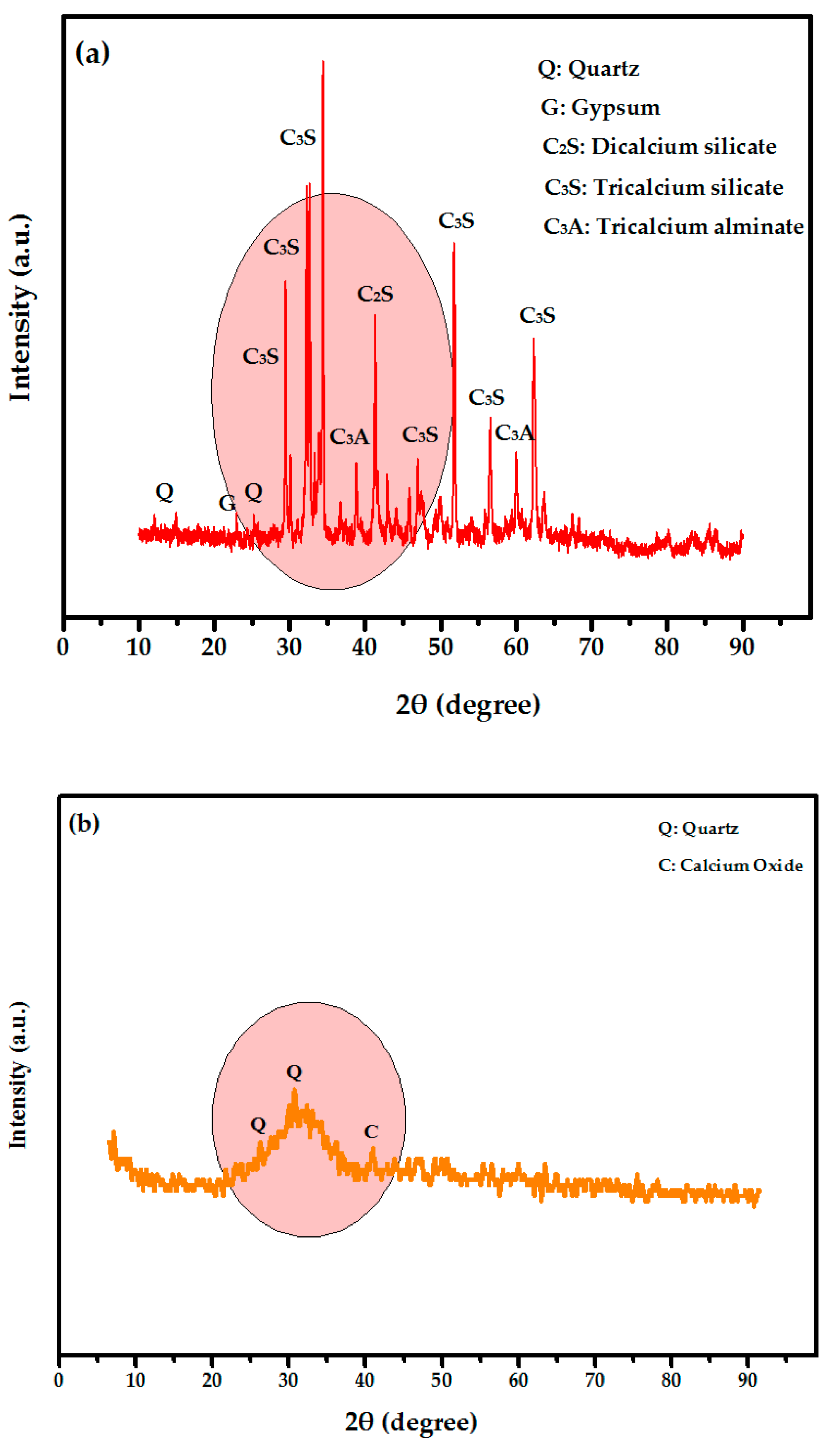
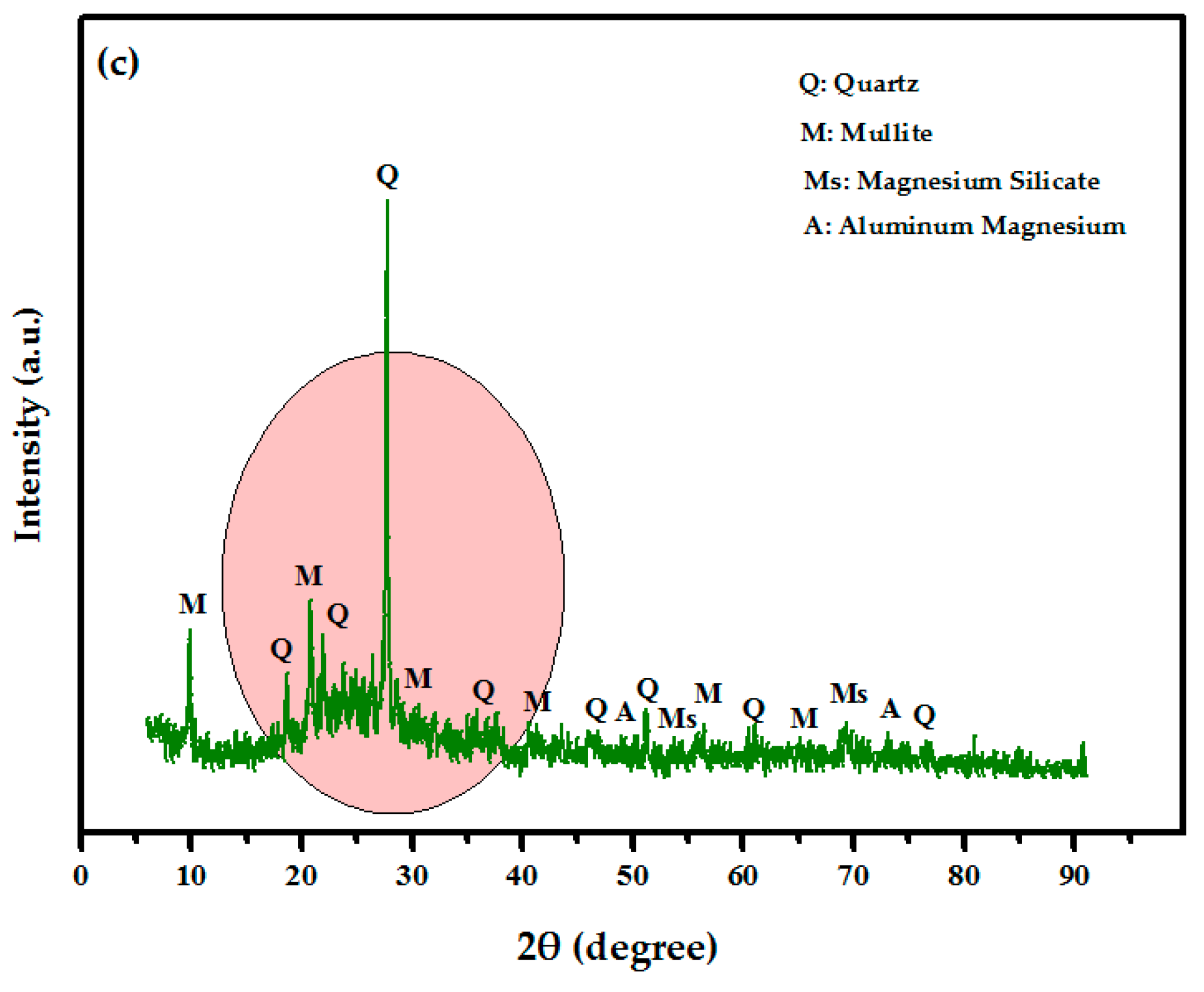

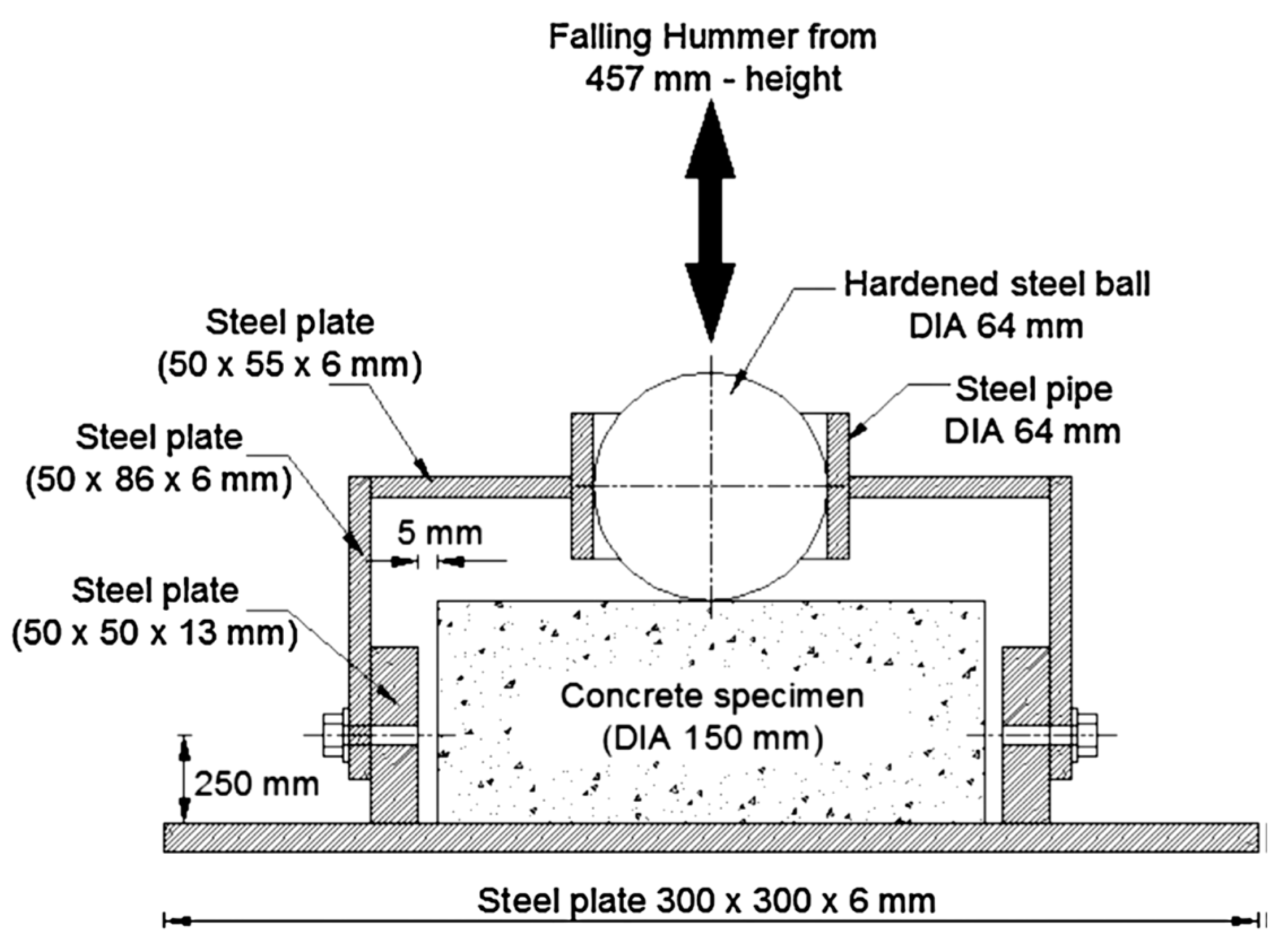
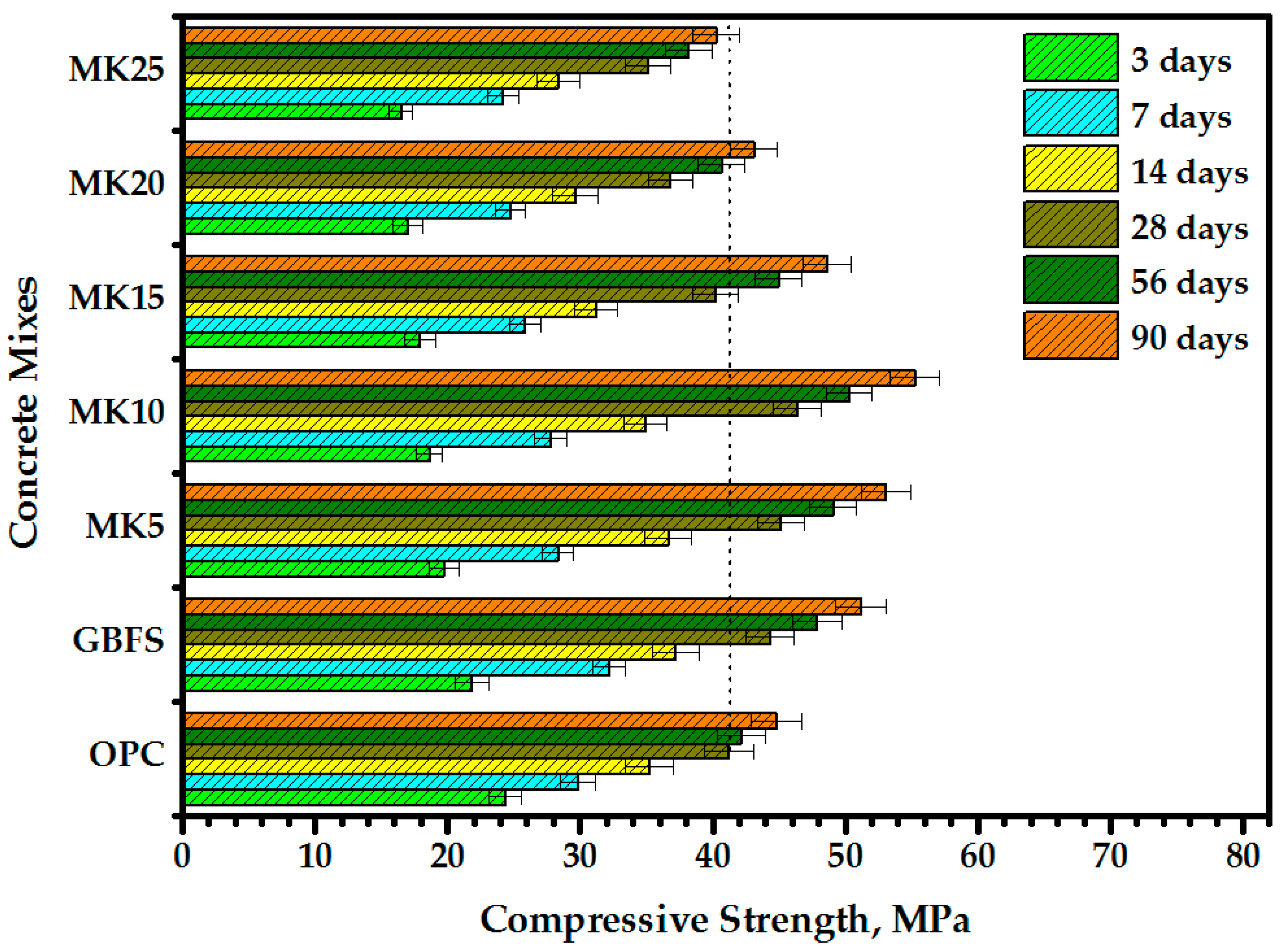

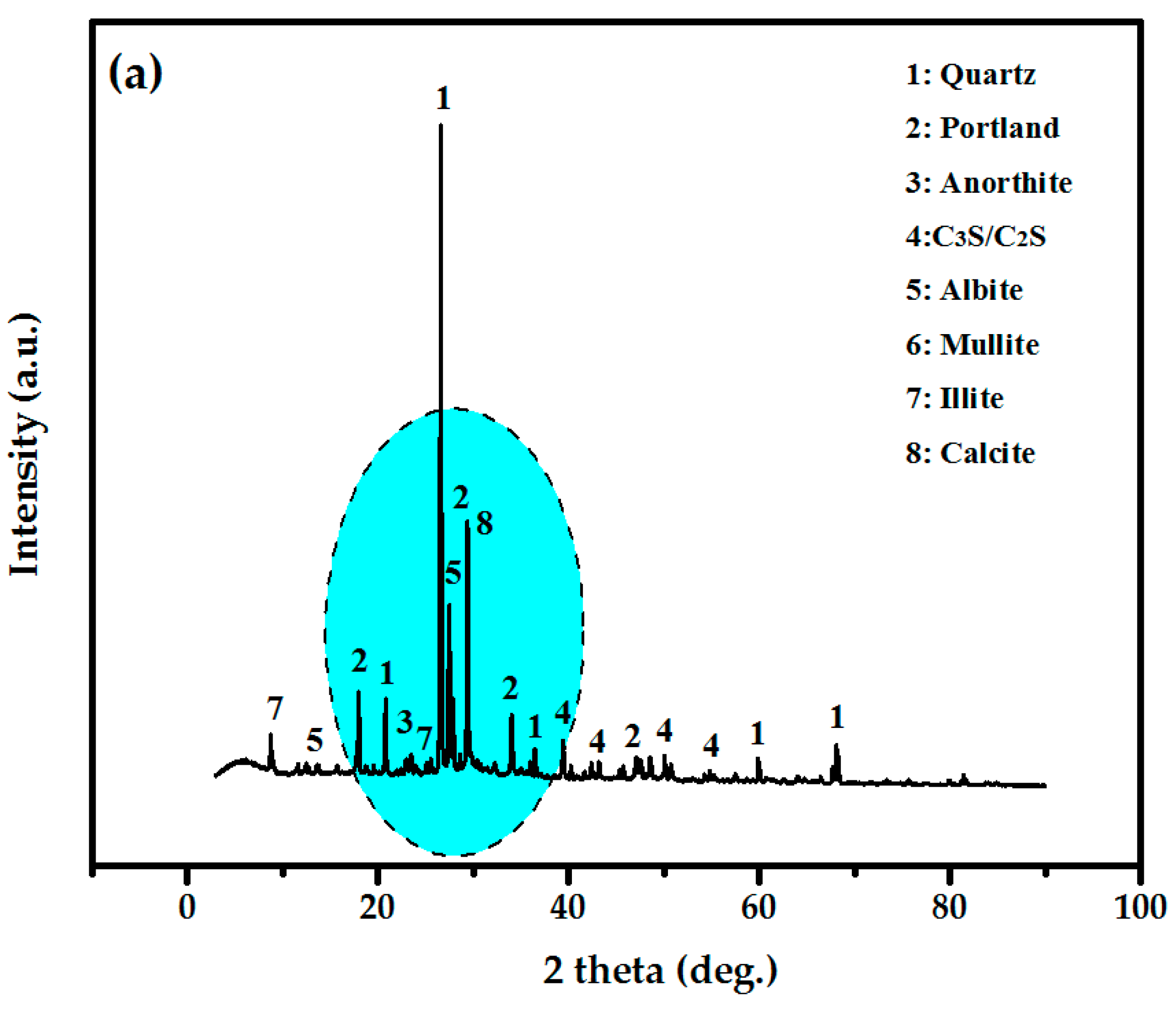


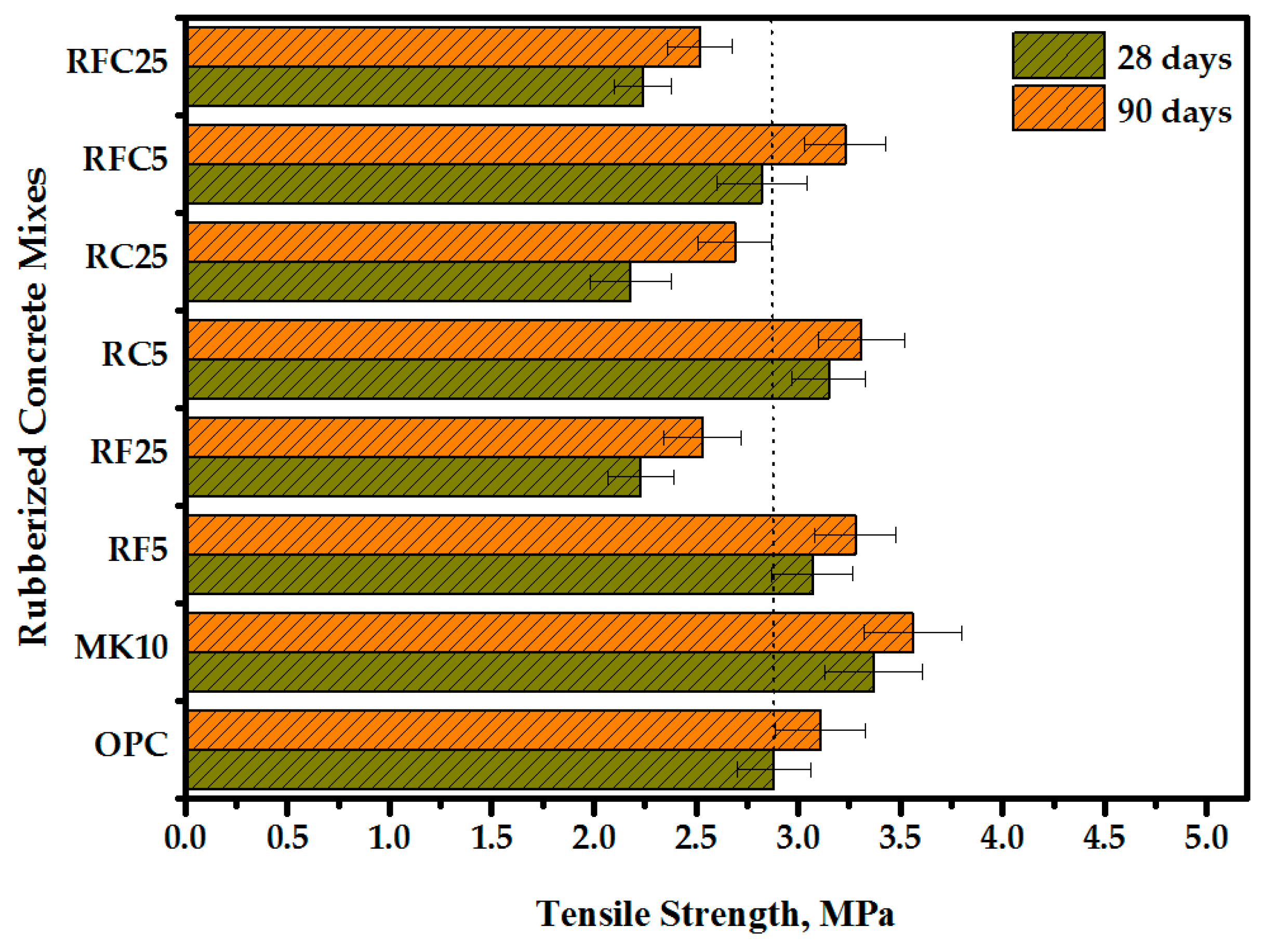


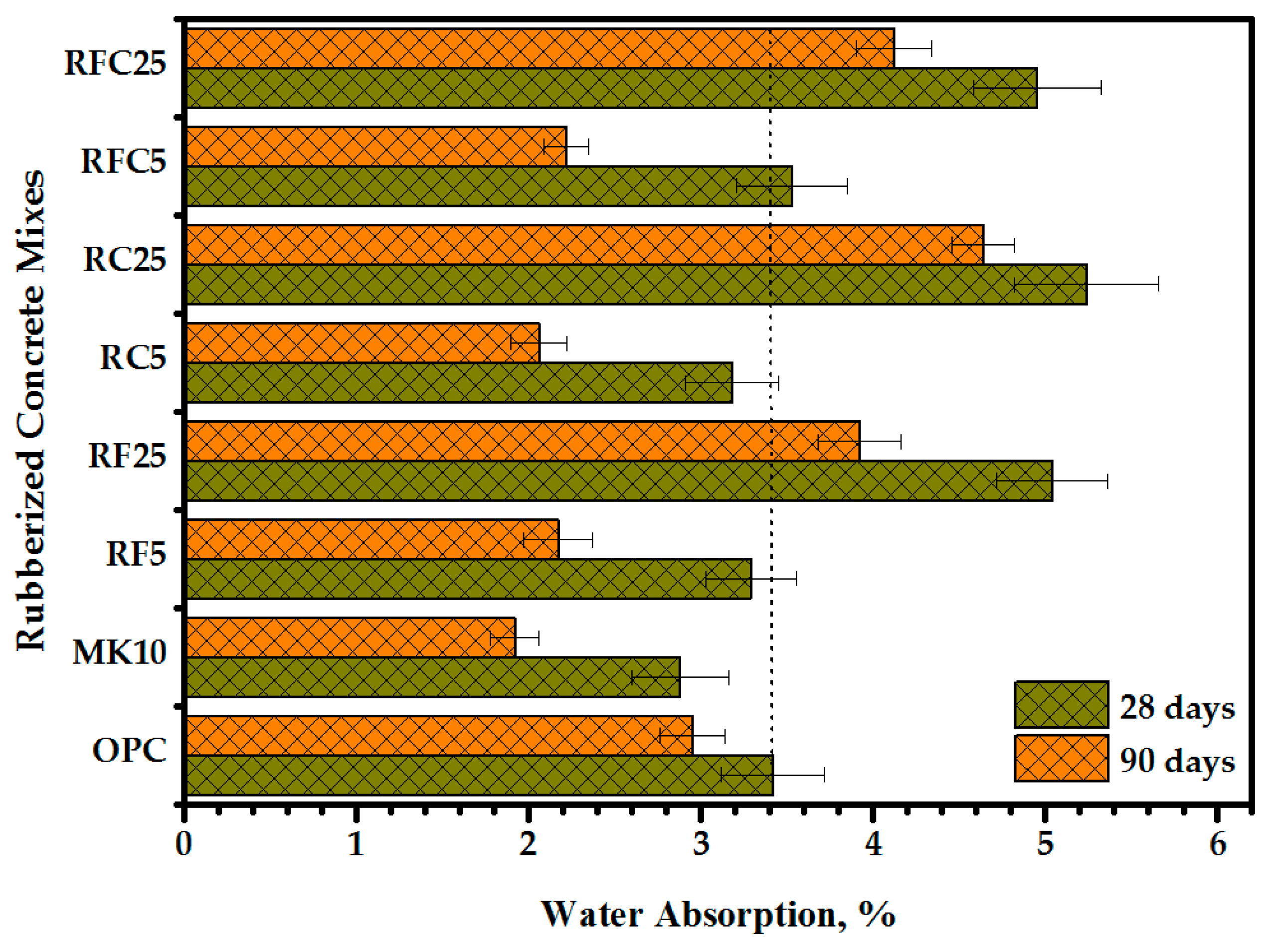
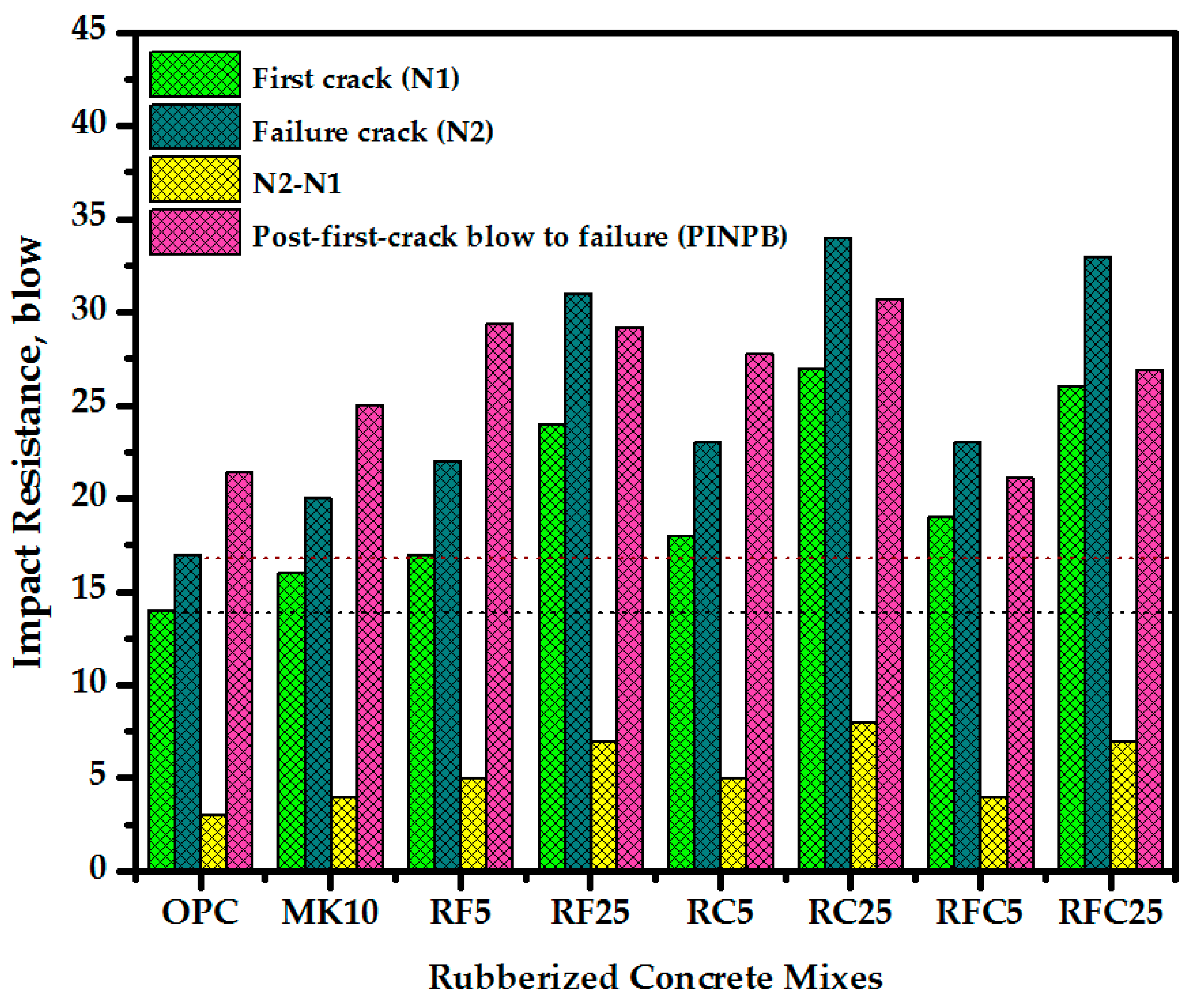
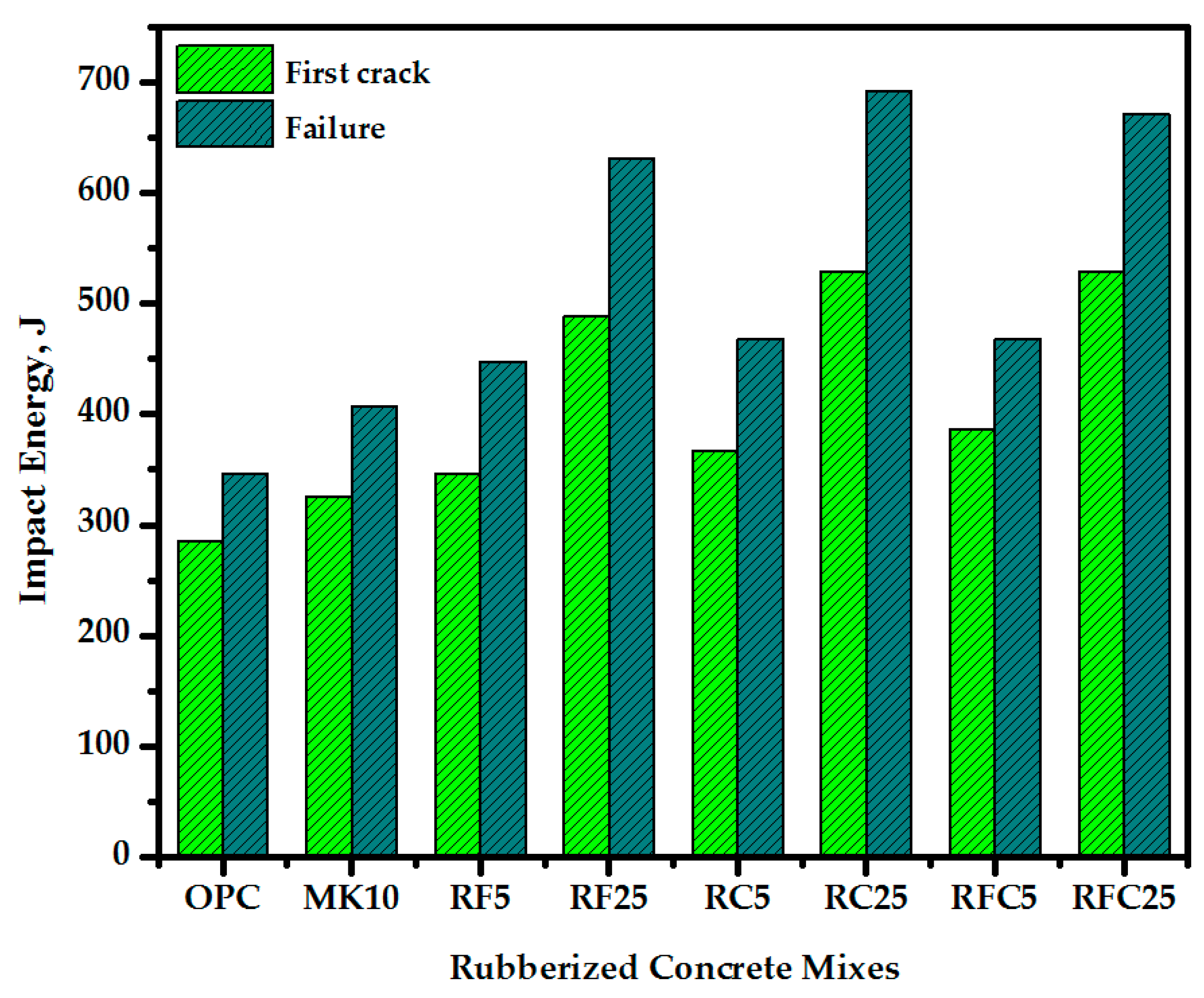
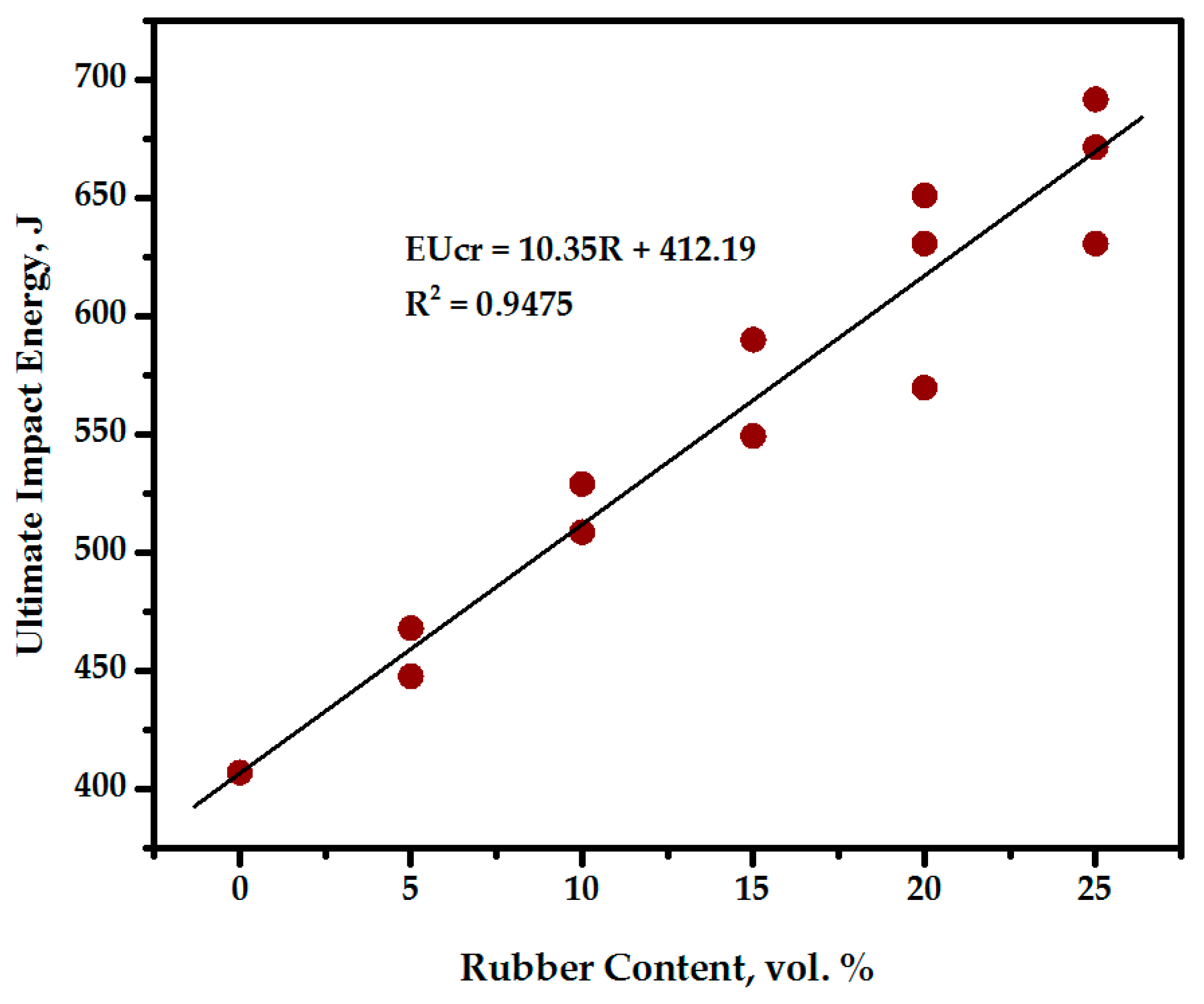

| Materials | SiO2 | Al2O3 | CaO | MgO | Fe2O3 | Na2O | K2O | TiO2 | MnO | P2O5 | LOI | Other |
|---|---|---|---|---|---|---|---|---|---|---|---|---|
| OPC | 17.62 | 4.56 | 67.84 | 2.15 | 3.37 | 0.02 | 0.28 | - | - | 0.02 | 1.69 | 2.45 |
| GBFS | 30.53 | 13.67 | 46.02 | 5.09 | 0.33 | 0.24 | 0.36 | 0.02 | - | 0.01 | 0.24 | 3.49 |
| MK | 52.22 | 42.18 | 0.08 | 0.26 | 0.49 | 0.01 | 1.73 | 0.01 | 0.01 | 0.13 | 1.65 | 1.23 |
| MRCs’ Mixes | Ternary Binder, kg/m3 | w/c Ratio | SP, % | NAs, kg/m3 | DSRTs, kg/m3 | |||||
|---|---|---|---|---|---|---|---|---|---|---|
| OPC | GBFS | MK | Fine | Coarse | Fine | Coarse | ||||
| Control specimens | OPC | 425 | 0 | 0 | 0.48 | 0.03 | 825 | 890 | 0 | 0 |
| Modified cement binder incorporating high content aluminosilicate materials of GBFS and MK | GBFS | 340 | 85 | 0 | 0.48 | 0.03 | 825 | 890 | 0 | 0 |
| MK5 | 318.7 | 85 | 21.3 | 0.48 | 0.03 | 825 | 890 | 0 | 0 | |
| MK10 | 297.5 | 85 | 42.5 | 0.48 | 0.03 | 825 | 890 | 0 | 0 | |
| MK15 | 276.3 | 85 | 63.7 | 0.48 | 0.03 | 825 | 890 | 0 | 0 | |
| MK20 | 255 | 85 | 85 | 0.48 | 0.03 | 825 | 890 | 0 | 0 | |
| MK25 | 233.7 | 85 | 106.3 | 0.48 | 0.03 | 825 | 890 | 0 | 0 | |
| DSRTs as 5, 10, 15, 20, and 25 volume % of fine aggregates replacement | RF5 | 297.5 | 85 | 42.5 | 0.48 | 0.03 | 804.17 | 890 | 20.83 | 0 |
| RF10 | 297.5 | 85 | 42.5 | 0.48 | 0.03 | 783.34 | 890 | 41.66 | 0 | |
| RF15 | 297.5 | 85 | 42.5 | 0.48 | 0.03 | 762.51 | 890 | 62.49 | 0 | |
| RF20 | 297.5 | 85 | 42.5 | 0.48 | 0.03 | 741.67 | 890 | 83.32 | 0 | |
| RF25 | 297.5 | 85 | 42.5 | 0.48 | 0.03 | 720.84 | 890 | 104.15 | 0 | |
| DSRTs as 5, 10, 15, 20, and 25 volume % coarse aggregates replacement | RC5 | 297.5 | 85 | 42.5 | 0.48 | 0.03 | 825 | 867.17 | 0 | 22.82 |
| RC10 | 297.5 | 85 | 42.5 | 0.48 | 0.03 | 825 | 844.34 | 0 | 45.65 | |
| RC15 | 297.5 | 85 | 42.5 | 0.48 | 0.03 | 825 | 821.51 | 0 | 68.48 | |
| RC20 | 297.5 | 85 | 42.5 | 0.48 | 0.03 | 825 | 798.68 | 0 | 91.31 | |
| RC25 | 297.5 | 85 | 42.5 | 0.48 | 0.03 | 825 | 775.86 | 0 | 114.14 | |
| DSRTs as5, 10, 15, 20, and 25 volume % fine and coarse aggregates replacement | RFC5 | 297.5 | 85 | 42.5 | 0.48 | 0.03 | 814.58 | 878.58 | 10.41 | 11.41 |
| RFC10 | 297.5 | 85 | 42.5 | 0.48 | 0.03 | 804.17 | 867.17 | 20.83 | 22.82 | |
| RFC15 | 297.5 | 85 | 42.5 | 0.48 | 0.3 | 793.75 | 855.76 | 31.24 | 34.24 | |
| RFC20 | 297.5 | 85 | 42.5 | 0.48 | 0.3 | 783.34 | 844.34 | 41.66 | 45.65 | |
| RFC25 | 297.5 | 85 | 42.5 | 0.48 | 0.3 | 772.92 | 832.92 | 52.07 | 57.07 | |
| Index | Amount, % | ||||
|---|---|---|---|---|---|
| Quartz | Portlandite | Calcite | Albite and Gismondine | Others | |
| OPC | 65.9 | 14.2 | 11.7 | 5.5 | 2.7 |
| MK10 | 67.7 | 10.6 | 12.5 | 7.8 | 1.4 |
Disclaimer/Publisher’s Note: The statements, opinions and data contained in all publications are solely those of the individual author(s) and contributor(s) and not of MDPI and/or the editor(s). MDPI and/or the editor(s) disclaim responsibility for any injury to people or property resulting from any ideas, methods, instructions or products referred to in the content. |
© 2024 by the authors. Licensee MDPI, Basel, Switzerland. This article is an open access article distributed under the terms and conditions of the Creative Commons Attribution (CC BY) license (https://creativecommons.org/licenses/by/4.0/).
Share and Cite
Joudah, Z.H.; Abdul Kareem, B. Engineering Properties of Modified Rubberized Concretes: Role of Metakaolin and Ground Blast Furnace Slag as Ordinary Portland Cement Replacements. Eng 2024, 5, 2067-2091. https://doi.org/10.3390/eng5030110
Joudah ZH, Abdul Kareem B. Engineering Properties of Modified Rubberized Concretes: Role of Metakaolin and Ground Blast Furnace Slag as Ordinary Portland Cement Replacements. Eng. 2024; 5(3):2067-2091. https://doi.org/10.3390/eng5030110
Chicago/Turabian StyleJoudah, Zahraa Hussein, and Baydaa Abdul Kareem. 2024. "Engineering Properties of Modified Rubberized Concretes: Role of Metakaolin and Ground Blast Furnace Slag as Ordinary Portland Cement Replacements" Eng 5, no. 3: 2067-2091. https://doi.org/10.3390/eng5030110






